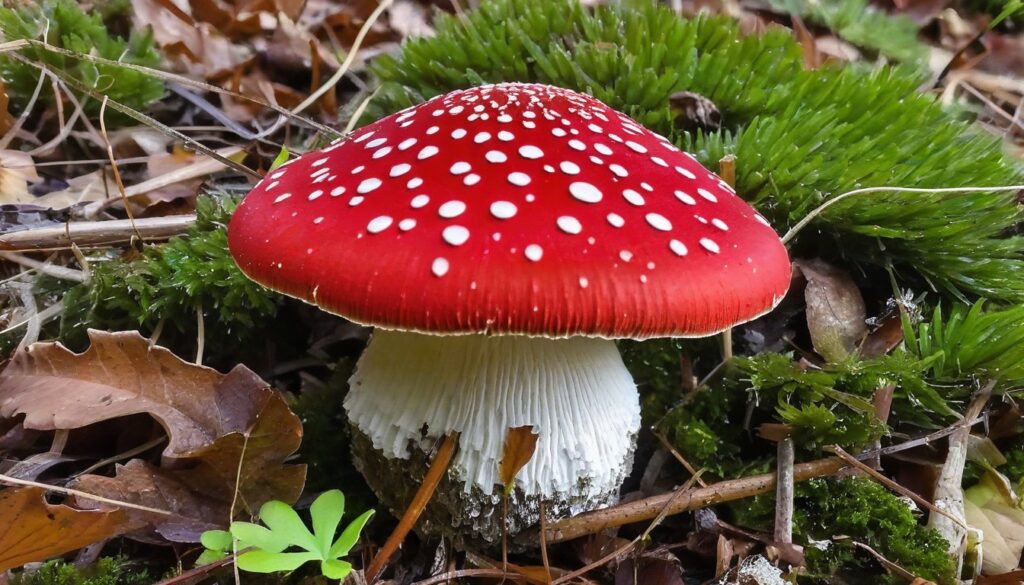Welcome to the fascinating world of red mushrooms found in the stunning state of Maine. If you’re an avid mushroom enthusiast or just starting, this guide offers essential insights into identifying, locating, and safely foraging these captivating organisms in Maine’s forests.
Key Takeaways:
- Learn to identify common species and their distinct features
- Explore prime locations across Maine for red mushroom spotting
- Understand safety precautions for mushroom hunting
- Discover edible red mushrooms and their culinary uses
- Practice ethical considerations and conservation efforts for responsible mushroom hunting
The Fascination of Red Mushrooms
Red mushrooms have always held a special place in the hearts of nature enthusiasts. Their vibrant colors and unique features make them stand out in the fungal kingdom, and they have been the subject of fascination for centuries.
One of the most striking things about red mushrooms is their appearance. With their bright red caps and striking shapes, they are hard to miss. For many mushroom hunters, spotting a red mushroom is a thrill that is hard to beat.
But there is more to red mushrooms than just their appearance. These fascinating fungi have an important role to play in the natural world, from providing food for wildlife to breaking down dead organic matter in the forest.
Whether you’re a seasoned mushroom hunter or simply someone who marvels at the wonders of the natural world, red mushrooms are sure to captivate your attention.
Identifying Red Mushrooms in Maine
Exploring Maine’s forests and discovering the enchanting world of red mushrooms is an exciting adventure. However, correctly identifying them is crucial for a safe and enjoyable experience. Let’s take a closer look at the different characteristics that can help us differentiate one species from another.
Color
Red mushrooms are obviously red, right? Well, not always. In fact, their colors can range from bright red to dark red, reddish-brown, and even orange. It’s essential to take note of the color variations of the cap, stem, and gills as they can differ from species to species. Pay close attention to any unusual colors, as some red mushrooms can be toxic.
Cap Shape
The cap of a mushroom is the top part that resembles an umbrella. Red mushroom caps can be round, spherical, flat, or even wavy. Some species’ caps have bumps and others edges. Different shapes and sizes can help differentiate between mushroom species.
Gills
When you look underneath the cap of a mushroom, you will see the gills – thin, blade-like structures that fan out from the stem. Gills can vary from narrow to wide, crowded or not crowded. Some red mushrooms have reddish gills, while others have white gills.
Spore Prints
Spores are a mushroom’s reproductive cells and are often released from the gills. To identify a mushroom’s species, you can take a spore print. Place the cap of the mushroom on a piece of paper, wait a few hours, and remove the cap. The spores will have left a pattern on the paper that can help identify the species of mushroom.
Remember, identifying red mushrooms in Maine can be challenging, so if you’re not 100% sure, it’s best to leave it alone. It’s important to stay safe while exploring these beautiful fungi in Maine’s forests.
Popular Red Mushroom Species in Maine
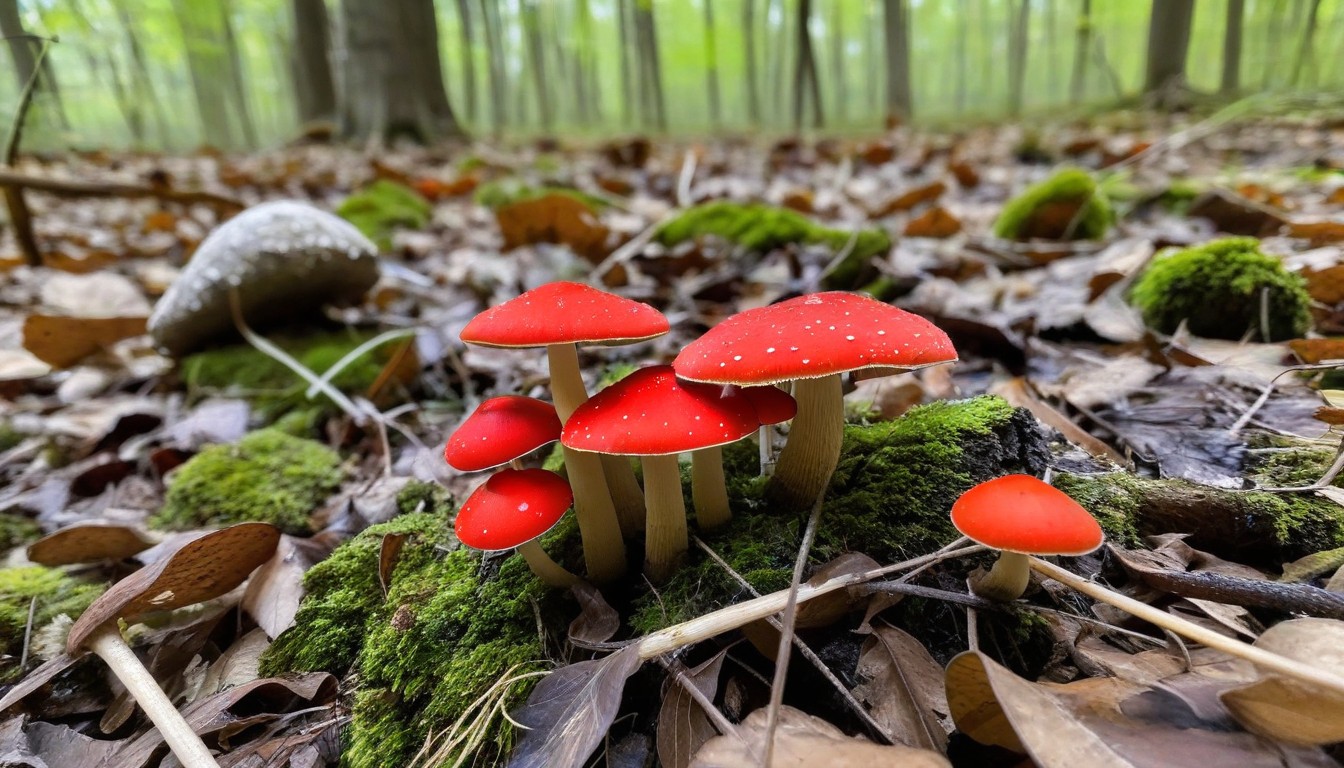
Maine is home to several species of red mushrooms that are commonly encountered in the state’s forests. Let’s dive into the fascinating world of these vibrant fungi and get familiar with their distinct features.
|
Mushroom Species |
Distinct Features |
|---|---|
|
Amanita muscaria |
This striking mushroom has a bright red cap with white spots and a bulbous stem. |
|
Russula emetica |
Also known as the vomiting Russula, this mushroom has a bright red cap and white gills that bruise yellow. |
|
Hygrocybe miniata |
This small mushroom has a bright red, convex cap and distinctively slender stem. |
|
Boletus luridus |
Commonly found in coniferous forests, this mushroom has a red to purple cap and yellow pores that turn blue when bruised. |
These species are just a few of the red mushrooms you may encounter in Maine’s forests. Remember to always use caution when identifying mushrooms and refer to a trusted guidebook or expert if you are unsure. Happy mushroom hunting!
Best Spots for Finding Red Mushrooms in Maine
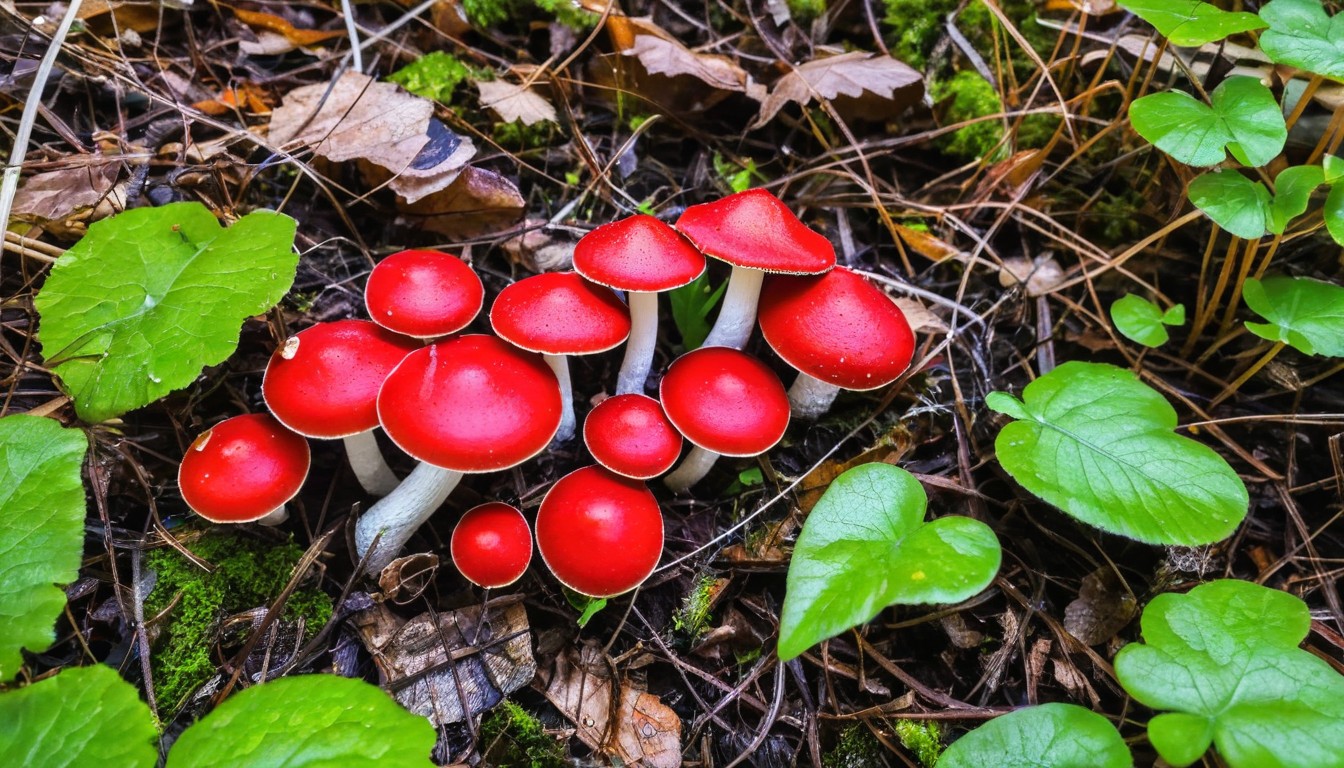
Are you ready to embark on a mushroom spotting adventure in Maine? Here are some of the best spots to find those vibrant red mushrooms:
|
Park/Forest |
Location |
Red Mushroom Species |
|---|---|---|
|
Acadia National Park |
Bar Harbor |
Amanita muscaria |
|
Baxter State Park |
Millinocket |
Russula emetica |
|
Allagash Wilderness Waterway |
Fort Kent |
Chalciporus piperatus |
|
Moosehorn National Wildlife Refuge |
Calais |
Lactarius deliciosus |
|
Rangeley Lakes Region |
Rangeley |
Boletus frostii |
These areas offer a diverse range of landscapes, from dense forests to mossy trails, each providing opportunities to discover unique species of red mushrooms. Remember to practice ethical foraging and follow safety precautions for a fun and safe mushroom spotting experience.
Safety Precautions for Mushroom Hunting
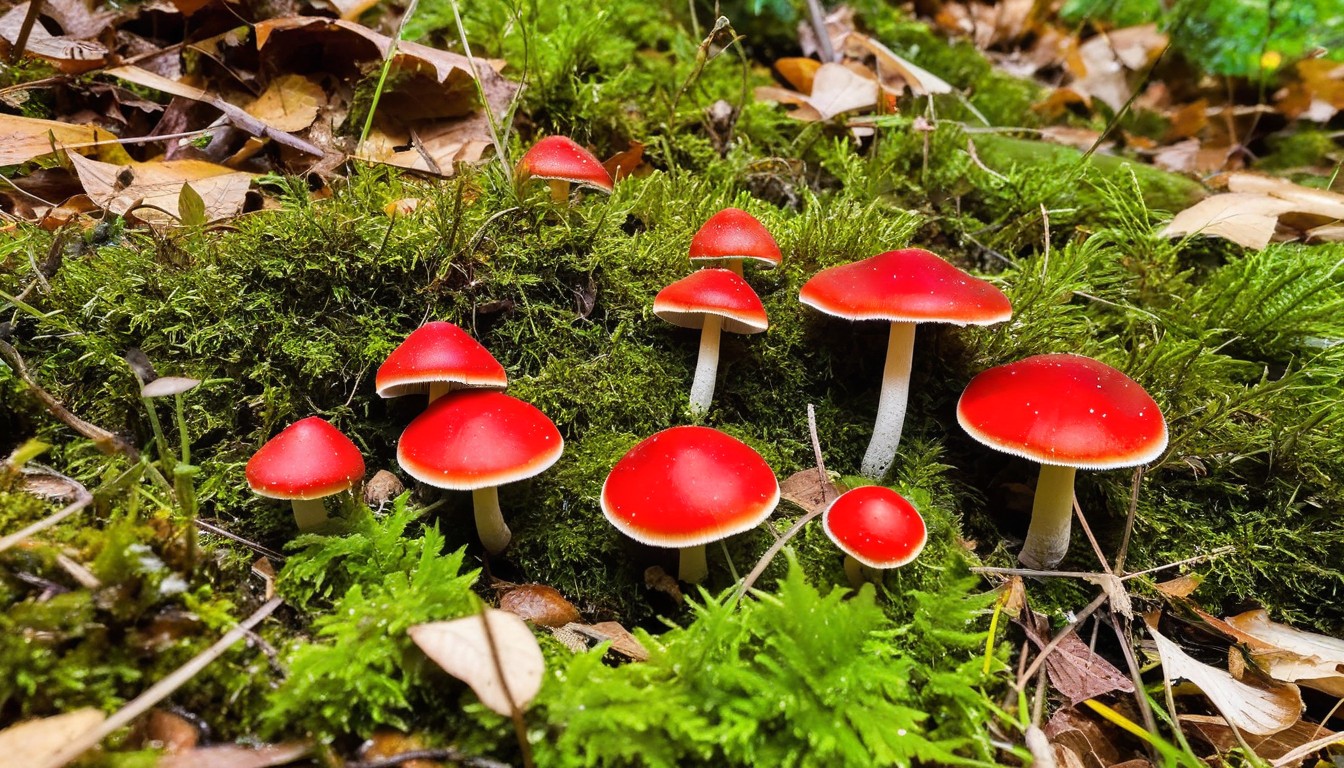
Exploring the forests of Maine for red mushrooms can be a thrilling activity, but it’s essential to prioritize safety to avoid any unpleasant accidents. Here are some safety precautions that every mushroom hunter should adhere to:
1. Identification of Poisonous Look-Alikes
There are many species of poisonous mushrooms that can quickly ruin a day of mushroom foraging. Therefore, learning to identify poisonous look-alikes is crucial for any amateur mushroom hunter. Several mushrooms, including the aptly named “Destroying Angel,” look very similar in appearance but can cause severe gastrointestinal distress and kidney damage.
2. Proper Handling Techniques
Mushrooms should be plucked carefully, ensuring not to damage the entire organism. It’s also wise to avoid handling mushrooms when your skin is wet or greasy to prevent damage to the mushroom’s outer layer. Also, use a basket for storing newly harvested mushrooms instead of a plastic or paper bag to prevent them from getting bruised or crushed.
3. Respectful Foraging Practices
When mushroom hunting, it’s crucial to take only what you need and leave the rest for other animals and fellow mushroom hunters. Additionally, do not uproot any mushrooms or disturb the forest’s soil, as this can cause long-lasting damage to the environment. Always respect nature and leave the forest as it was before your visit.
|
Do not collect: |
Collect only: |
|---|---|
|
Mushrooms with slimy or sticky caps |
Mushrooms with dry caps |
|
Decay or old mushrooms |
Youthful specimens |
|
Mushrooms with strong smells |
Mushrooms with mild smells |
|
Mushrooms with insects or worms |
Clean mushrooms |
By following these safety precautions, mushroom hunters can enjoy a safe and pleasurable experience in the forests of Maine.
Edible Red Mushrooms in Maine
Maine is home to a variety of delightful edible red mushrooms, each with its own unique flavor and culinary uses. Here are two of the most popular:
|
Species |
Description |
Culinary Uses |
|---|---|---|
|
Lobster Mushroom |
The Lobster Mushroom, also known as Hypomyces lactifluorum, is a distinctive looking mushroom with a firm texture and a delicate, seafood-like flavor. It grows on various species of mushrooms, turning them a bright, reddish-orange color. |
The Lobster Mushroom is delicious when sautéed or used in soups, stews, and sauces. |
|
Red-Capped Scaber Stalk |
The Red-Capped Scaber Stalk, or Leccinum aurantiacum, is a meaty mushroom with a nutty flavor and a firm texture. It has a bright red cap and a yellow stem. |
The Red-Capped Scaber Stalk is best when sautéed or used in marinades and sauces. |
If you are lucky enough to come across edible red mushrooms during your adventures in Maine’s forests, make sure to properly identify them and exercise caution before consuming. Always cook mushrooms thoroughly and start by consuming a small portion to ensure that you are not allergic to them.
Conservation and Ethical Considerations
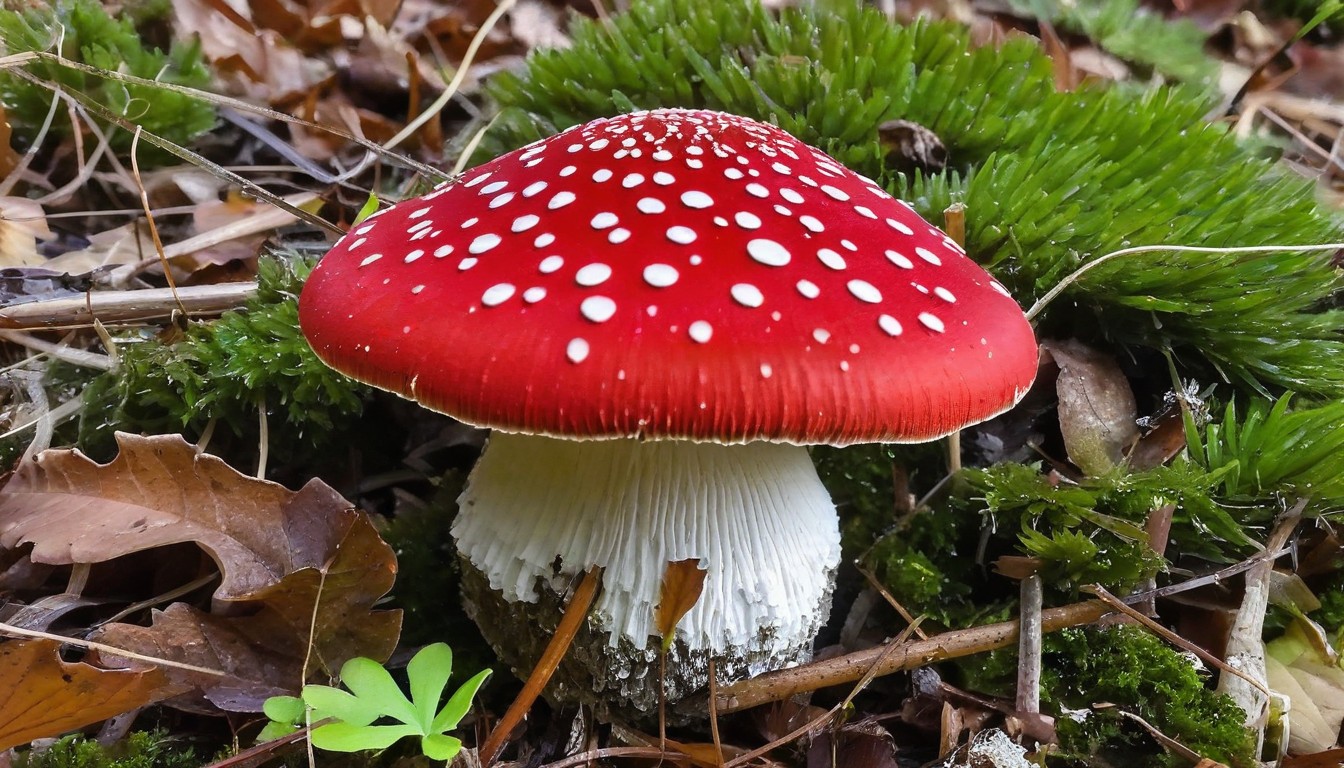
As mushroom enthusiasts, it’s our responsibility to ensure the conservation of red mushrooms in Maine’s ecosystems. These delicate organisms play a vital role in the environment and should be treated with utmost care and respect. To preserve and protect them, we must consider ethical foraging practices that prioritize the well-being of the ecosystem.
When foraging for red mushrooms, it’s important to follow guidelines to avoid damaging the forest ecosystem. For example, don’t pick all the mushrooms you find in one location, leave some behind so that they can continue to spread their spores. Additionally, avoid trampling on wildflower beds or disturbing the soil as this can have long-term effects on the forest’s ecosystem.
Furthermore, certain species of red mushrooms are considered endangered or threatened. Ethical considerations should come into play when deciding whether or not to harvest them. It’s essential to educate oneself on the status of the mushroom species and follow guidelines in place to prevent over-harvesting.
Conservation Efforts
Conservation efforts for red mushrooms in Maine are focused on raising public awareness and conducting ongoing research. Organizations like the Maine Mycological Association (MMA) work towards this goal by conducting workshops and education programs and by conducting surveys to study the populations of red mushroom species in Maine.
Another organization, the Maine Department of Conservation, has implemented guidelines for mushroom foraging, emphasizing ethical and sustainable practices. Some of these guidelines include avoiding picking mushrooms in sensitive areas, harvesting in small quantities, and using appropriate tools to prevent soil disturbance.
|
Conservation Tips |
Ethical Considerations |
|---|---|
|
|
By practicing responsible mushroom hunting and foraging, we can ensure the sustainability of red mushrooms in Maine’s beautiful forests for generations to come.
Red Mushroom Photography Tips
Capturing the vibrant beauty of red mushrooms in Maine is a rewarding experience for any nature photographer. Here are some essential tips to help you get the perfect shot:
1. Be Mindful of Lighting
The right lighting can make or break your mushroom photos. Avoid direct sunlight and opt for diffused lighting in dimly lit areas. This can help highlight the colors and textures of the mushrooms and prevent harsh shadows.
2. Experiment with Composition
Don’t be afraid to play around with composition to create interesting and dynamic shots. Try different angles, perspectives, and framing techniques to add depth and dimension to your photos.
3. Get Up Close with Macro Photography
Mushrooms offer intricate and detailed patterns that can be captured beautifully with macro photography. Experiment with different lenses and aperture settings to get up-close shots that showcase the unique features of each species.
“Photography takes an instant out of time, altering life by holding it still.” – Dorothea Lange
4. Use a Tripod
Keeping your camera steady is essential for capturing sharp, clear images of mushrooms. A tripod can help eliminate camera shake and allow you to experiment with longer exposure settings for creative effects.
5. Edit with Care
Editing can enhance the beauty of your mushroom photos but use it judiciously. Avoid over-editing and stick to natural-looking enhancements that showcase the unique colors and textures of each mushroom species.
With these tips, you’ll be on your way to capturing stunning photographs of red mushrooms in Maine!
Conclusion
In conclusion, exploring the world of red mushrooms in Maine is a fascinating and educational experience for nature lovers and mushroom enthusiasts alike. This guide has provided you with valuable insights into identifying red mushrooms, the best spots to find them, and important safety precautions to follow while mushroom hunting.
It’s also essential to practice ethical foraging practices and conservation efforts to protect the delicate ecosystems where these vibrant fungi thrive. By doing so, we can ensure that future generations can continue to enjoy the beauty and benefits of these remarkable organisms.
Remember to bring your camera and capture the captivating beauty of red mushrooms with stunning photographs using the techniques and tips shared in this guide.
So, what are you waiting for? Grab your foraging basket, put on your hiking boots, and immerse yourself in the enchanting world of red mushrooms in Maine. Happy mushroom hunting!
FAQ
How can I identify red mushrooms in Maine?
To identify red mushrooms in Maine, look for characteristics such as color, cap shape, gills, and spore prints. Consulting a field guide or seeking the expertise of a mycologist can also be helpful.
Are all red mushrooms in Maine safe to eat?
No, not all red mushrooms in Maine are safe to eat. Some species can be highly toxic or deadly. It is crucial to exercise caution and only consume mushrooms that have been positively identified as edible by an expert.
Where are the best spots to find red mushrooms in Maine?
Prime locations for finding red mushrooms in Maine include Acadia National Park, Baxter State Park, and other dense forests and mossy trails with suitable growing conditions.
What safety precautions should I take while mushroom hunting?
When mushroom hunting, it is important to be aware of poisonous look-alikes, handle mushrooms properly to avoid contamination, and practice sustainable foraging techniques to protect both the mushrooms and the ecosystem.
Can I use my red mushroom photographs for commercial purposes?
The usage of red mushroom photographs for commercial purposes may require obtaining proper licensing and permissions, especially if the images feature identifiable locations or copyrighted elements. It is advisable to consult legal professionals or online resources to ensure compliance with copyright laws.
How can I contribute to the conservation of red mushrooms in Maine?
To contribute to the conservation of red mushrooms in Maine, it is essential to adhere to ethical foraging practices, such as not overharvesting, not damaging the habitat, and leaving no trace. Supporting conservation efforts and organizations dedicated to preserving fungi and their ecosystems can also make a significant impact.
Are lobsters mushrooms found in Maine edible?
Yes, lobsters mushrooms found in Maine are edible. However, as with any wild mushroom, proper identification is essential. It is recommended to consult an expert or reference reliable resources before consuming any wild mushrooms.
What popular red mushroom species can I find in Maine?
Some popular red mushroom species found in Maine include Amanita muscaria and Russula emetica. Each species has distinct features, and it’s important to familiarize yourself with their identification characteristics before encountering them in the wild.

